Isabella Bradford's Blog, page 11
June 21, 2018
Friday Video: Was This Jacket Worn at the Battle of Waterloo?
Susan reporting,
"Provenance" is an important word among museum curators, and refers to the history of an artifact or artwork. Sometimes the provenance is detailed and indisputable, a sure trail from one owner to another. More often, however, facts become a bit hazy, particularly with historical garments. Family traditions and wishful thinking often contribute to create breathless stories about how "this dress was worn by my great-great-great-grandmother when she danced with the Marquis de Lafayette", and are often taken with a big grain of salt by curators.
The uniform jacket featured in this video had a tradition of having been worn by Sir Thomas Noel Harris, Brigade-Major, at the Battle of Waterloo. He danced at the Duchess of Richmond's ball before being called to join his regiment, and then fought unscathed until the last day of the battle. A musket ball - or perhaps two? - pierced both his arm and his side, severely wounding him. He lay among the dead and dying on the battlefield overnight, until he was discovered by a searching family member and taken to a dressing station. There his arm was amputated, but he did survive and recover, and continue to serve in the army.
But was this really Sir Thomas's jacket, and was it in fact worn by him at Waterloo? This video shows the different scientific tests used by the Cranfield Forensic Institute to answer that question. It's a fascinating mix of CSI-style forensic examination plus the known history of the jacket, the wearer, and the battle.
If you received this post via email, you may be seeing only a black box or empty space where the video should be. Please click here to view the video.
Published on June 21, 2018 18:00
June 18, 2018
From the Archives: Intrepid Women: Elizabeth Thompson, Lady Butler: Painter of Battles & Soldiers

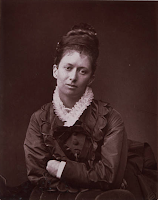 Since this week is marks the commemoration of the Battle of Waterloo (the battle was fought on June 18, 1815), this painting and its celebrated artist seem like the perfect subject to share again.
Since this week is marks the commemoration of the Battle of Waterloo (the battle was fought on June 18, 1815), this painting and its celebrated artist seem like the perfect subject to share again.Susan reporting,
Being a professional painter in Victorian England was a difficult path for a woman, but for Elizabeth Southerden Thompson (1846-1933), left, success came swiftly, and with unexpected subjects.
Born in Switzerland to wealthy English parents who believed in travel as a form of education, Elizabeth began her art training in Italy and London as a teenager, concentrating on religious subjects. While studying in Paris, she first saw the work of French painters chronicling heroic battle scenes. Inspired, her first military history painting, Missing, earned her admission to the Royal Academy in 1873.

But it was Calling the Roll after an Engagement, Crimea, or The Roll Call, right, (click on the images to enlarge) painted in 1874 when she was only 28, that made her a celebrity. Showing the haggard survivors of a battalion of Grenadiers answering the roll call after a battle, the painting was an enormous success, drawing such great crowds that a special policeman was hired to keep order. In an unprecedented move, the painting was even removed from the Academy wall and carried to Buckingham Palace so Queen Victoria could view it privately. Her Majesty was as impressed as everyone else, and bought the picture for the royal collection.
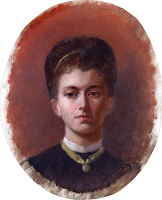
Miss Thompson next turned to Waterloo for inspiration, completing The 28th Regiment at Quatre Bras, below left, in 1875, another popular success. Her large, detailed canvases were the equivalent of big-screen extravaganzas that fed the imagination and patriotism of the British Empire, then at its pinnacle. But she also focused on the suffering of the ordinary soldier, emphasising the cost of war as well as its glory. Her battle pictures are also unusual because they most often depict the scene from the (doubtless intimidated) enemy's point of view, who are seldom shown. She was fastidious in her research, having replica uniforms made for her models. More military-themed paintings followed, and she became one of the most acclaimed artists of her time.
The public was not only fascinated by the art, but Miss Thompson herself. How was it that a young and attractive English lady could paint such vivid scenes of heroism and suffering that Crimea veterans praised their accuracy? Even the influential art critic John Ruskin was impressed by Quatre Bras - in spite of his determined preconceptions:

"I never approached a picture with more iniquitous prejudice against it than I did Miss Thompson's; partly because I have always said that no woman could paint; and, secondly, because I thought that what the public made such a fuss about must be good for nothing. But it is...the first fine Pre-Raphaelite picture of battle we have had; profoundly interesting, and showing all manner of illustrative and realistic faculty. Of course, all that need be said of it...must have been said twenty times over in the journals; and it remains only for me to make my tardy genuflexion, on the trampled corn, before this Pallas of Pall Mall."
In 1877 she married Sir William Francis Butler, and her career fell behind not only that of her husband, an officer in the British Army, but her new role as a mother. She joined her husband on his posts around the world – Egypt, Zanzibar, South Africa, as well as his home in Ireland – and bore and raised their six children. While her artistic production diminished, she still continued to paint military scenes, including the heroic Scotland Forever!, above, in 1881. Regarded as her finest painting, it's also undeniably her most dramatic, depicting the start of the charge of the Royal Scots Greys at the Battle of Waterloo in 1815. (To show how cinematic this painting is - and the influence it had upon later movie-makers - see this clip of the same charge from the 1970 movie Waterloo.) She also painted and drew scenes from her travels.

But the most lasting blow to Lady Butler's career is one that many artists face. By the beginning of the twentieth century, tastes in painting had changed, and her meticulously detailed history paintings were seen as hopelessly old-fashioned in the face of new, more abstract movements like Cubism. Even more damning was the shifting perception of armies and battles after the modern horrors of World War One. The grand heroic warfare with patriotic gestures and splendid uniforms of the past no longer had a place in the public imagination, and in 1924, the last painting she submitted to the Royal Academy was rejected. She died in 1933.
In addition to her paintings, Lady Butler also wrote three books, including her autobiography. It's available to read or download for free here ; her illustrations, like the one lower right, are included and are wonderful, full of excitement that matches the life she lived.
Top: Scotland Forever!, 1881, Leeds Art Gallery.
Upper right: Calling the Roll after an Engagement, Crimea, (or The Roll Call), 1874, The Royal Collection Trust.
Upper left: The 28th Regiment at Quatre Bras, 1875, National Gallery of Victoria.
Middle right: Self-Portrait by Elizabeth Southerden Thompson, Lady Butler, 1869, National Portrait Gallery.
Lower right: "Got it, Bravo!" illustration from An Autobiography, 1922.
Published on June 18, 2018 19:00
Being Elsewhere
 Loretta reports:
Loretta reports:I have no report. With apologies, there will be no Nerdy History Girl blog post from me today, because it's too late at night to pretend to be intelligent about history. This is because I didn't come back soon enough from where I was away to. Instead I offer all the preceding prepositions in places some people will say are wrong.
And the pictures are from where I was late coming back from, on the Maine coast in paradise. So maybe you won't blame me for not hurrying back.

Published on June 18, 2018 02:43
June 16, 2018
Breakfast Links: Week of June 11, 2018
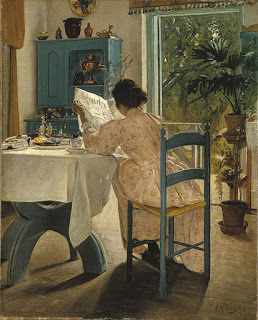 Breakfast Links are served! Our weekly round-up of fav links to other web sites, articles, blogs, and images via Twitter.
Breakfast Links are served! Our weekly round-up of fav links to other web sites, articles, blogs, and images via Twitter.• A cup of tea , made the 18thc way.
• The rebozo : fashion, feminism, and death.
• Lily of Liberty: Amelia Bloomer at 200.
• Thomas Bewick's cat .
• Anne Finch, Countess of Winchilsea, 17thc poet - and perhaps a pre-Romantic?
• Face of a suffragette: previously unknown footage of Emily Wilding Davison discovered.
• Faith Trumbull : the artist was a young girl.
• Image: The Silver Streak Iron , c1946 may be the most beautiful iron ever made.
• Did 18thc heiress Mary Blandy poison her father's oatmeal?
• Rainbow-colored beasts from a 15thc Book of Hours.
• Murder on the Titanic: the nightmare one survivor from Rhode Island never forgot.
• Blue moons, honeymoons, and moons made of green cheese: • Early Modern memes: recycling and reusing 17thc woodcuts in popular print.
• Catching up on Beatnik fashion.
• Image: "The latest style of ladies' muff is provided with a pocket for the owner's pet dog" 1895.
• When Connecticut led the nation in the production of pins.
• An x-ray of a Civil War wound? A hapless re-enactor accidentally shot himself with an 1860s gun.
• Might we interest you in a dog-powered velocipede?
• Quick quiz: can you match these archaic names for Hungry for more? Follow us on Twitter @2nerdyhistgirls for fresh updates daily.
Above: At Breakfast by Laurits Andersen Ring. Private collection.
Published on June 16, 2018 14:00
June 14, 2018
Friday Video: Wilma Rudolph, the Unstoppable
 Wilma Rudolph wins in Rome 1960
Loretta reports:
Wilma Rudolph wins in Rome 1960
Loretta reports:My husband, who also is a Nerdy History Person (although suffering from a less virulent form of the disease), sent me this article: How Wilma Rudolph Became the World’s Fastest Woman . Not being a Sports Person, I had only recognized her name—something to do with Olympics? That’s as far as it went. Then I read her story, and kept on looking for more and more. She survived and conquered ordeals that would have crushed many of us—well, me, definitely. How about polio and poverty, to start with?
Biography Channel Video: Mini Bio: Wilma Rudolph
You can find many bios online, including this one and this one .
Image: Image: Rudolph convincingly wins the women's 100 meter dash at the 1960 Summer Olympics in Rome .
Readers who receive our blog via email might see a rectangle, square, or nothing where the video ought to be. To watch the video, please click on the title to this post (which will take you to our blog) or the video title (which will take you to YouTube).
Published on June 14, 2018 21:30
June 13, 2018
A Formal Ball Gown from the French Court, c1780
 Susan reporting,
Susan reporting,For fashion historians, there are some garments from the past that become celebrities in their own right, featured over and over in books, exhibitions, and on Pinterest. These garments have earned this status for a number of reasons: because of the fame of the original owner or maker, exceptional craftsmanship, rare textiles or embellishments, or simply because of their beauty.
(As always, please click on the images to enlarge them. I know these photos are a bit dark, but the galleries were low-lit to preserve the textiles - a fair trade-off.)
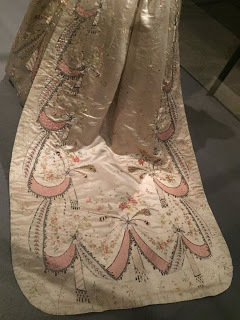
The dress shown here qualifies on every count. It's currently on display through July 29, 2018 at the Metropolitan Museum of Art as part of the Visitors to Versailles: 1682-1789 exhibition (see here , here , and here for my posts featuring other objects from the exhibition.) This exquisite ball gown, or robe parée, would have been worn at only the most formal occasions at the French court at Versailles in the late 18thc.. Once linked to Queen Marie-Antoinette herself, the gown is still attributed to the queen's dressmaker, Marie Jeanne "Rose" Bertin (1747-1813).
The gown definitely belonged to a woman of very high status at the court, and it's exactly the kind of luxurious and costly garment that would bring the ire of French revolutionaries a decade later. Not only is the surface design - featuring draped ribbons, flowers, and peacock feathers - sophisticated and elegant, but the execution of the embroidery on the cream-colored silk satin is extraordinary. The list of the elements on the exhibition placard shows the complexity of the the needlework: silk embroidery, appliques of satin, metallic threads, chenille, sequins, and applied glass paste. Everything was designed to sparkle by candlelight, and make the wearer the center of attention as she danced.
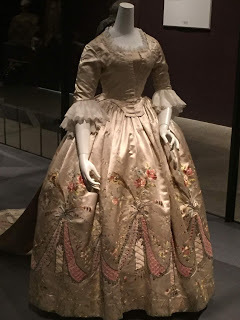
What to me is even more extraordinary is that the gown remains a showpiece even though it has been significantly altered. Originally worn over the wide hoops (pannier) required for 18thc court dress, a later owner had the petticoat (skirt) narrowed to a bell-shape and the bodice remade to conform to mid-19thc tastes, and likely to make it more wearable and lighter as well. The ruffles shown are also later additions. No matter: it's still breathtakingly beautiful.
Formal Ball Gown, attributed to Marie Jeanne "Rose" Bertin, c1780s, Royal Ontario Museum, Toronto. Photographs ©2018 Susan Holloway Scott.
Published on June 13, 2018 18:00
June 11, 2018
From the Archives: They Do It Differently in France, Part One
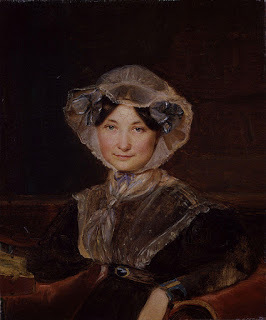 Frances Trollope ca 1832
Loretta reports:
Frances Trollope ca 1832
Loretta reports:[Note: This post is from 2010, when I was researching my Dressmakers series. In light of recent discussions about the differences in the way married and unmarried women dressed, it seemed worth a return engagement.]
I had occasion to reopen my yellowed copy of Fanny Trollope’s Paris and the Parisians recently, and was reminded what a delightful account she offers of Paris in 1835. I suggest you read the entire Letter XXXV —which I have had to hack up mercilessly below. It points out a very interesting cultural difference.
By this time, in England, arranged marriages were a thing of the past, but not in France. This led to some interesting differences in social behavior. In France, Fanny tells us, the unmarried girls are the last to get dancing partners. It’s the married women—and many of them no spring chickens—to whom all the young gallants flock. She discusses this oddity with an unnamed French woman of her acquaintance, who asks, "Will you then have the kindness to explain to me the difference in this respect between France and England ?"
Fanny: " The only difference between us which I mean to advocate is, that with us the amusement which throws young people together under circumstances the most likely, perhaps, to elicit expressions of gallantry and admiration from the men, and a gracious reception of them from the women, is considered as befitting the single rather than the married part of the community."
" With us, indeed, it is exactly the reverse," replied she,—" at least as respects the young ladies. By addressing the idle, unmeaning gallantry inspired by the dance to a young girl, we should deem the cautious delicacy of restraint in which she is enshrined transgressed and broken in upon. A young girl should be given to her husband before her passions have been awakened or her imagination excited by the voice of gallantry.…When a girl is first married, her feelings, her thoughts, her imagination, are wholly occupied by her husband. Her mode of education has ensured this; and afterward it is at the choice of her husband whether he will secure and retain her young heart for himself. In no country have husbands so little reason to complain of their wives as in France ; for in no country does the manner in which they live with them depend so wholly on themselves.”
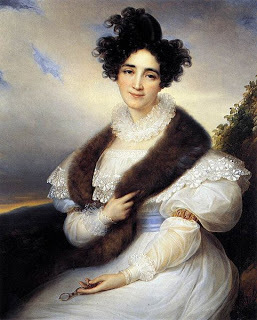 Marie J. Lafont-Porcher ca 1835
After politely debating which country has got it all wrong, the Unnamed Lady concludes: “…as we go on exchanging fashions so amicably, who knows but we may live to see your young ladies shut up a little more, while their mothers and fathers look out for a suitable marriage for them, instead of inflicting the awkward task upon themselves?* And in return, perhaps, our young wives may lay aside their little coquetries, and become mères respectables somewhat earlier than they do now. But, in truth, they all come to it at last."
Marie J. Lafont-Porcher ca 1835
After politely debating which country has got it all wrong, the Unnamed Lady concludes: “…as we go on exchanging fashions so amicably, who knows but we may live to see your young ladies shut up a little more, while their mothers and fathers look out for a suitable marriage for them, instead of inflicting the awkward task upon themselves?* And in return, perhaps, our young wives may lay aside their little coquetries, and become mères respectables somewhat earlier than they do now. But, in truth, they all come to it at last."*Italics mine.
Images: Frances Trollope , by Auguste Hervieu circa 1832, courtesy National Portrait Gallery NPG 3906 via Wikipedia. François Kinson, Portrait of Marie J. Lafont-Porcher circa 1835, courtesy Groeningemuseum, via Wikipedia.
Published on June 11, 2018 21:30
June 10, 2018
The More Things Change....Every Mother's (Small) Nightmare, c1835
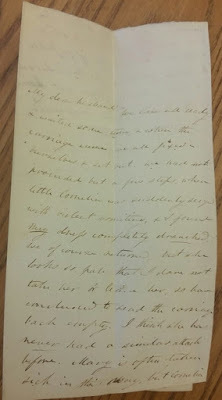 Susan reporting,
Susan reporting,One of the best things about the internet is how many smaller historical societies, libraries, archives, and historic sites are now able to share their collections with the world - a world that might not otherwise know they exist. Today I'm encouraging you to check out the Tumblr account of the Litchfield (CT) Historical Society. Named Fresh and Fashionable Goods, the account features all kinds of fascinating excerpts from the Elijah Boardman Papers. The Tumblr is funded by the National Historical Publications and Records Commission, National Archives, and for us Nerdy History Folk, this is taxpayer money absolutely well spent. The finding aid to the papers is here , and the digitized material is online here .
Some of the papers in the Society's collection represent familiar names like merchant, real estate investor, and politician Benjamin Tallmadge (1754-1835), better remembered as one of General George Washington's spymasters during the American Revolution.
Most, however, are the work of lesser-known men and women. To me, these papers are the most fascinating, because they offer such a clear glimpse into everyday life: what ordinary people ate, bought, grew, and used, what amused them and what didn't.
The hastily written note shown left (and here ) is a wonderful example of how some aspects of that everyday life haven't changed one bit in the last 180 or so years. Caroline Maria Boardman Schroeder (1802-1853) was born into a prominent and prosperous Litchfield County family. In 1825, she married John Frederick Schroeder (1800-1857), a celebrated cleric, scholar, reformer, author, inventor, and educator. They had eight children, and their third daughter, Cornelia, is the one mentioned in this note. While the note is undated, it's a good guess that Cornelia (1831-1914) was quite young at the time, so Caroline's note probably dates from the mid-1830s. Here's the transcription:
My dear husband
We were all ready & waited some time & when the carriage came we all fixed ourselves & set out. We had not proceeded but a few steps, when little Cornelia was suddenly seized with violent vomiting, and I found my dress completely drenched. We of course returned, but she looks so pale that I dare not take her or leave her, so have concluded to send the carriage back empty. I think she has never had a similar attack before. Mary [Cornelia's older sister] is often taken sick in this way, but Cornelia never. I think her stomach was overloaded. I will stay with her, & wish you if possible to make apologies for me whenever it is necessary. Please get some of the best calcium magnesia as I have none.
Affectionately yours,
Caroline
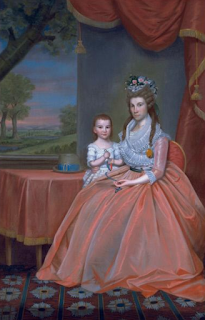
While today this note would be sent as a harried text between parents, the scenario it describes is all too familiar to anyone with small children. Dad has gone ahead to some special event, Mom is running a little late, but has the kids dressed in their best clothes and finally loaded into the car, and then the youngest...explodes, leaving Dad to make excuses and stop by the drug store to pick up a fresh bottle of much-needed Pepto Bismal.
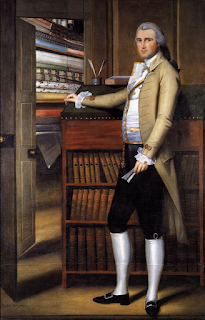 Still, Caroline's concerns for little Cornelia were sadly well-founded. Caroline and John had eight children. Their first two, Caroline and George, died as newborns, while scarlet fever later claimed their middle daughter Mary, 10, and son William, only three months. Caroline's mother, Mary Ann Whiting Boardman, wrote a concerned letter to her heartbroken daughter about the sorrowful loss of little Mary and the risk of grieving too much that you can read
here
.
Still, Caroline's concerns for little Cornelia were sadly well-founded. Caroline and John had eight children. Their first two, Caroline and George, died as newborns, while scarlet fever later claimed their middle daughter Mary, 10, and son William, only three months. Caroline's mother, Mary Ann Whiting Boardman, wrote a concerned letter to her heartbroken daughter about the sorrowful loss of little Mary and the risk of grieving too much that you can read
here
.I don't have a portrait of Caroline Boardman Schroeder, but I can't resist sharing the portraits of her parents, Mary Ann Whitman Boardman, right, (with her eldest son William Whiting Boardman) and Elijah Boardman, lower left, both by Ralph Earl. They're two of my favorite portraits from the era; I'm sure that many of the readers of this blog will fondly recognize merchant Elijah's portrait, because he's posed with bolts and bolts of fabric - a dream stash of 18thc textiles.
Many thanks to Linda Hocking, Archivist, Litchfield Historical Society for her assistance with this post.
Upper left: Note from Caroline Maria Boardman Schroeder to John Frederick Schroeder, n.d., Litchfield Historical Society.
Right: Mrs. Elijah Boardman and Her Son by Ralph Earl, c1796, The Huntington.
Lower left: Elijah Boardman by Ralph Earl, 1789, Metropolitan Museum of Art.
Published on June 10, 2018 17:00
The More Things Change....The Challenge of Traveling with a Car(riage)-Sick Child, c1835
 Susan reporting,
Susan reporting,One of the best things about the internet is how many smaller historical societies, libraries, archives, and historic sites are now able to share their collections with the world - a world that might not otherwise know they exist. Today I'm encouraging you to check out the Tumblr account of the Litchfield (CT) Historical Society. Named Fresh and Fashionable Goods, the account features all kinds of fascinating excerpts from the letters, receipts, and ledgers of Litchfield's 18thc-19thc townspeople. The Tumblr is funded by the National Historical Publications and Records Commission, National Archives, and for us Nerdy History Folk, this is taxpayer money absolutely well spent.
Some of the papers in the Society's collection represent familiar names like merchant, real estate investor, and politician Benjamin Tallmadge (1754-1835), better remembered as one of General George Washington's spymasters during the American Revolution.
Most, however, are the work of lesser-known men and women. To me, these papers are the most fascinating, because they offer such a clear glimpse into everyday life: what ordinary people ate, bought, grew, and used, what amused them and what didn't.
The hastily written note shown left (and here ) is a wonderful example of how some aspects of that everyday life haven't changed one bit in the last 180 or so years. Caroline Maria Boardman Schroeder (1802-1853) was born into a prominent and prosperous Litchfield County family. In 1825, she married John Frederick Schroeder (1800-1857), a celebrated cleric, scholar, reformer, author, inventor, and educator. They had eight children, and their third daughter, Cornelia, is the one mentioned in this note. While the note is undated, it's a good guess that Cornelia (1831-1914) was quite young at the time, so Caroline's note probably dates from the mid-1830s. Here's the transcription:
My dear husband
We were all ready & waited some time & when the carriage came we all fixed ourselves & set out. We had not proceeded but a few steps, when little Cornelia was suddenly seized with violent vomiting, and I found my dress completely drenched. We of course returned, but she looks so pale that I dare not take her or leave her, so have concluded to send the carriage back empty. I think she has never had a similar attack before. Mary [Cornelia's older sister] is often taken sick in this way, but Cornelia never. I think her stomach was overloaded. I will stay with her, & wish you if possible to make apologies for me whenever it is necessary. Please get some of the best calcium magnesia as I have none.
Affectionately yours,
Caroline

While today this note would be sent as a harried text between parents, the scenario it describes is all too familiar to anyone with small children. Dad has gone ahead to some special event, Mom is running a little late, but has the kids dressed in their best clothes and finally loaded into the car, and then the youngest...explodes, leaving Dad to make excuses and stop by the drug store to pick up a fresh bottle of much-needed Pepto Bismal.
 Still, Caroline's concerns for little Cornelia were sadly well-founded. Caroline and John had eight children. Their first two, Caroline and George, died as newborns, while scarlet fever later claimed their middle daughter Mary, 10, and son William, only three months. Caroline's mother, Mary Ann Whitman Boardman, wrote a concerned letter to her heartbroken daughter about the sorrowful loss of little Mary and the risk of grieving too much that you can read
here
.
Still, Caroline's concerns for little Cornelia were sadly well-founded. Caroline and John had eight children. Their first two, Caroline and George, died as newborns, while scarlet fever later claimed their middle daughter Mary, 10, and son William, only three months. Caroline's mother, Mary Ann Whitman Boardman, wrote a concerned letter to her heartbroken daughter about the sorrowful loss of little Mary and the risk of grieving too much that you can read
here
.I don't have a portrait of Caroline Boardman Schroeder, but I can't resist sharing the portraits of her parents, Mary Ann Whitman Boardman, right, (with her eldest son William Whiting Boardman) and Elijah Boardman, lower left, both by Ralph Earl. They're two of my favorite portraits from the era; I'm sure that many of the readers of this blog will fondly recognize merchant Elijah's portrait, because he's posed with bolts and bolts of fabric - a dream stash of 18thc textiles.
Many thanks to Linda Hocking, Archivist, Litchfield Historical Society for her assistance with this post.
Upper left: Note from Caroline Maria Boardman Schroeder to John Frederick Schroeder, n.d., Litchfield Historical Society.
Right: Mrs. Elijah Boardman and Her Son by Ralph Earl, c1796, The Huntington.
Lower left: Elijah Boardman by Ralph Earl, 1789, Metropolitan Museum of Art.
Published on June 10, 2018 17:00
June 9, 2018
Breakfast Links: Week of June 4, 2018
 Breakfast Links are served! Our weekly round-up of fav links to other web sites, articles, blogs, and images via Twitter.
Breakfast Links are served! Our weekly round-up of fav links to other web sites, articles, blogs, and images via Twitter.• Radical philosopher Mary Wollstonecraft's adventures in 1795 Scandinavia.
• Susan Fennimore Cooper , forgotten naturalist, artist, and author of both fiction and non-fiction.
• How the City Gates of London appeared before they were torn down.
• Not fated to be: the love letters of 18thc soldier Alexander Scammell .
• The creation of color in 18thc Europe.
• The secrets of a 19th diary written on the floorboards of a castle.
• Image: Rumor has it that the bills for this 18thc state bed were ripped up so no one could know how much it cost.
• A " home for penitents ", a "home for unwed mothers": was this Liverpool's Magdalene Laundry?
• Chasing the vanishing playgrounds of our youth.
• The recipes of Cleopatra .
• The death and life of the St. Denis , a great American building now doomed by development.
• Image: George Washington's pounce box , used during the American Revolution.
• Royal acorns in the wallpaper at Hampton Court palace.
• Forgotten voices of the British Empire : the charge of the 21st Lancers, 1898.
• Mrs. Headman's preparations : safeguarding secrets in a Victorian beauty business.
• The All-American Girls Professional Baseball League was founded 75 years ago, and made baseball history.
• A brief look at medieval shoes.
• The record-breaking pandemic of 1918: the forgotten year of death .
• Tripping down memory lane: the '60s menswear company H.I.S.
Hungry for more? Follow us on Twitter @2nerdyhistgirls for fresh updates daily.
Above: At Breakfast by Laurits Andersen Ring. Private collection.
Published on June 09, 2018 14:00



